Research Design: Intelligent Transport System and Traffic Congestion
VerifiedAdded on 2023/04/11
|14
|2386
|487
Report
AI Summary
This report presents a systematic survey and analysis of the Intelligent Transport System (ITS) approach to traffic congestion, relevant to the field of environmental engineering. It examines the application of ITS in developing countries facing issues like traffic congestion, infrastructure constraints, and high traffic loads. The research employs an inductive approach, using research questions to narrow the study's scope, focusing on various methodologies, including wireless sensor networks, traffic flow prediction using deep learning, and automated driving's impact on traffic efficiency. The report reviews existing literature, identifies research gaps, and explores topics such as urban traffic management, traffic flow prediction with big data, short-term traffic forecasting, and the use of the Internet of Things and cooperative autonomous vehicles. The design precedent highlights the use of wireless sensor networks, big data, and automation. The report concludes by identifying gaps in ITS research and the need for further investigation into the relationship between ITS and implementation issues.
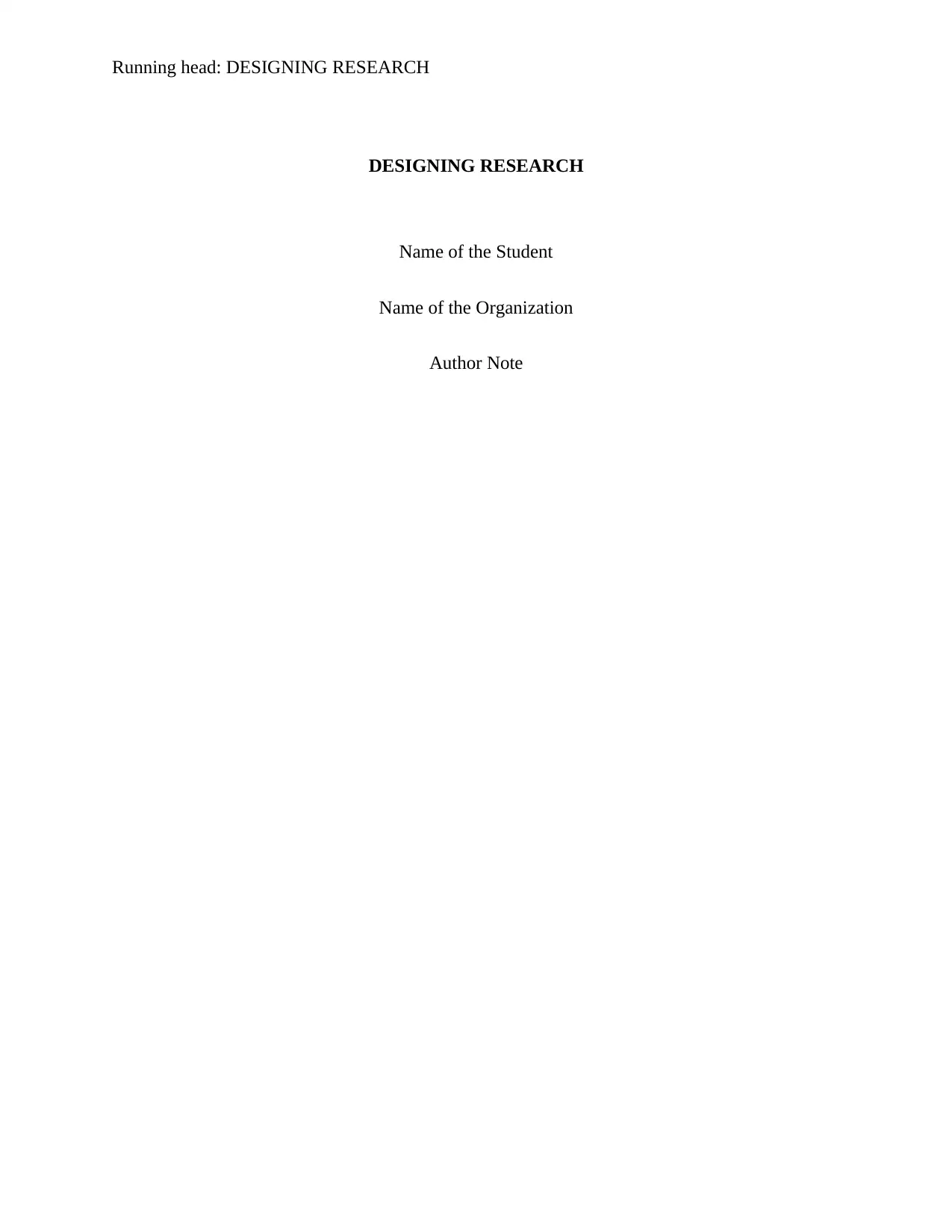
Running head: DESIGNING RESEARCH
DESIGNING RESEARCH
Name of the Student
Name of the Organization
Author Note
DESIGNING RESEARCH
Name of the Student
Name of the Organization
Author Note
Paraphrase This Document
Need a fresh take? Get an instant paraphrase of this document with our AI Paraphraser
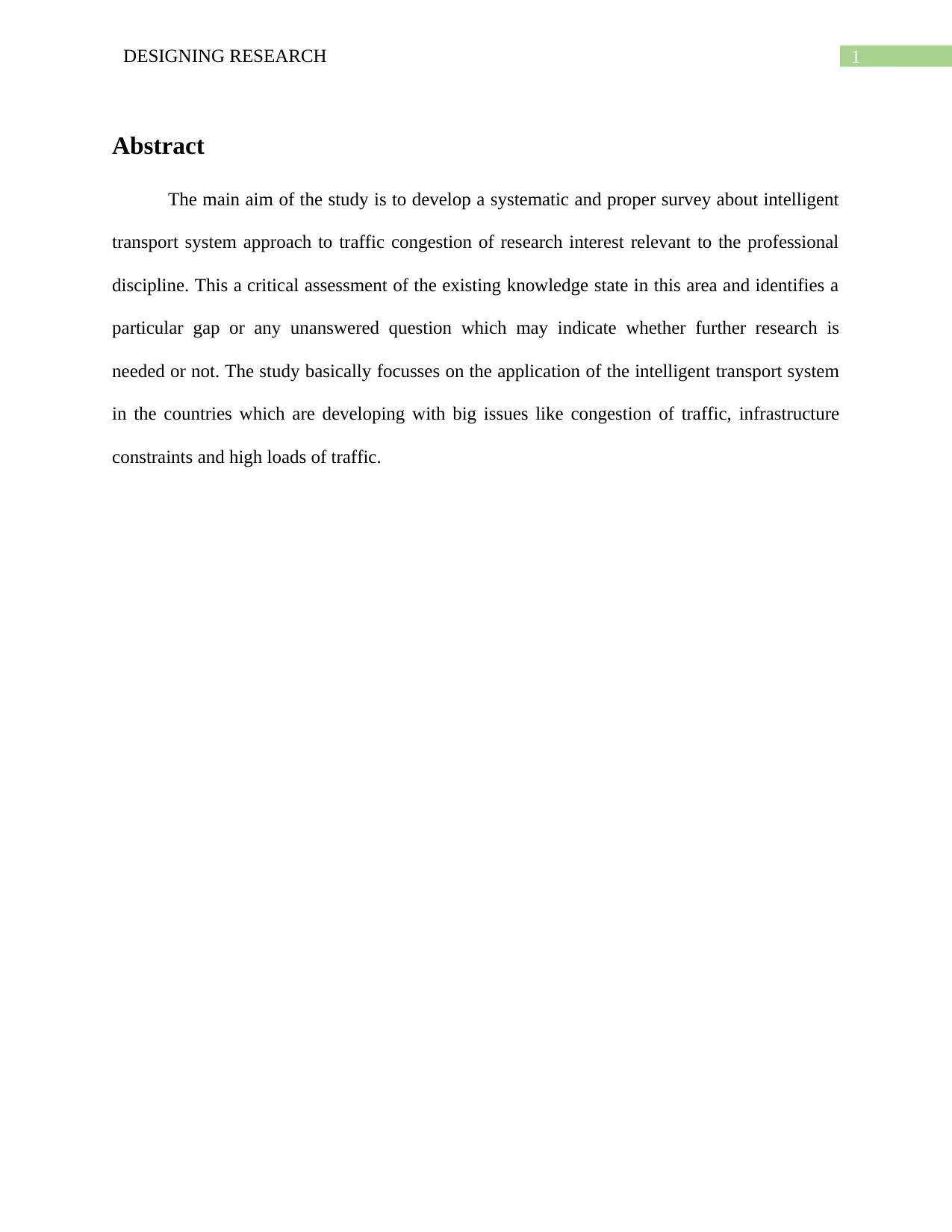
1DESIGNING RESEARCH
Abstract
The main aim of the study is to develop a systematic and proper survey about intelligent
transport system approach to traffic congestion of research interest relevant to the professional
discipline. This a critical assessment of the existing knowledge state in this area and identifies a
particular gap or any unanswered question which may indicate whether further research is
needed or not. The study basically focusses on the application of the intelligent transport system
in the countries which are developing with big issues like congestion of traffic, infrastructure
constraints and high loads of traffic.
Abstract
The main aim of the study is to develop a systematic and proper survey about intelligent
transport system approach to traffic congestion of research interest relevant to the professional
discipline. This a critical assessment of the existing knowledge state in this area and identifies a
particular gap or any unanswered question which may indicate whether further research is
needed or not. The study basically focusses on the application of the intelligent transport system
in the countries which are developing with big issues like congestion of traffic, infrastructure
constraints and high loads of traffic.
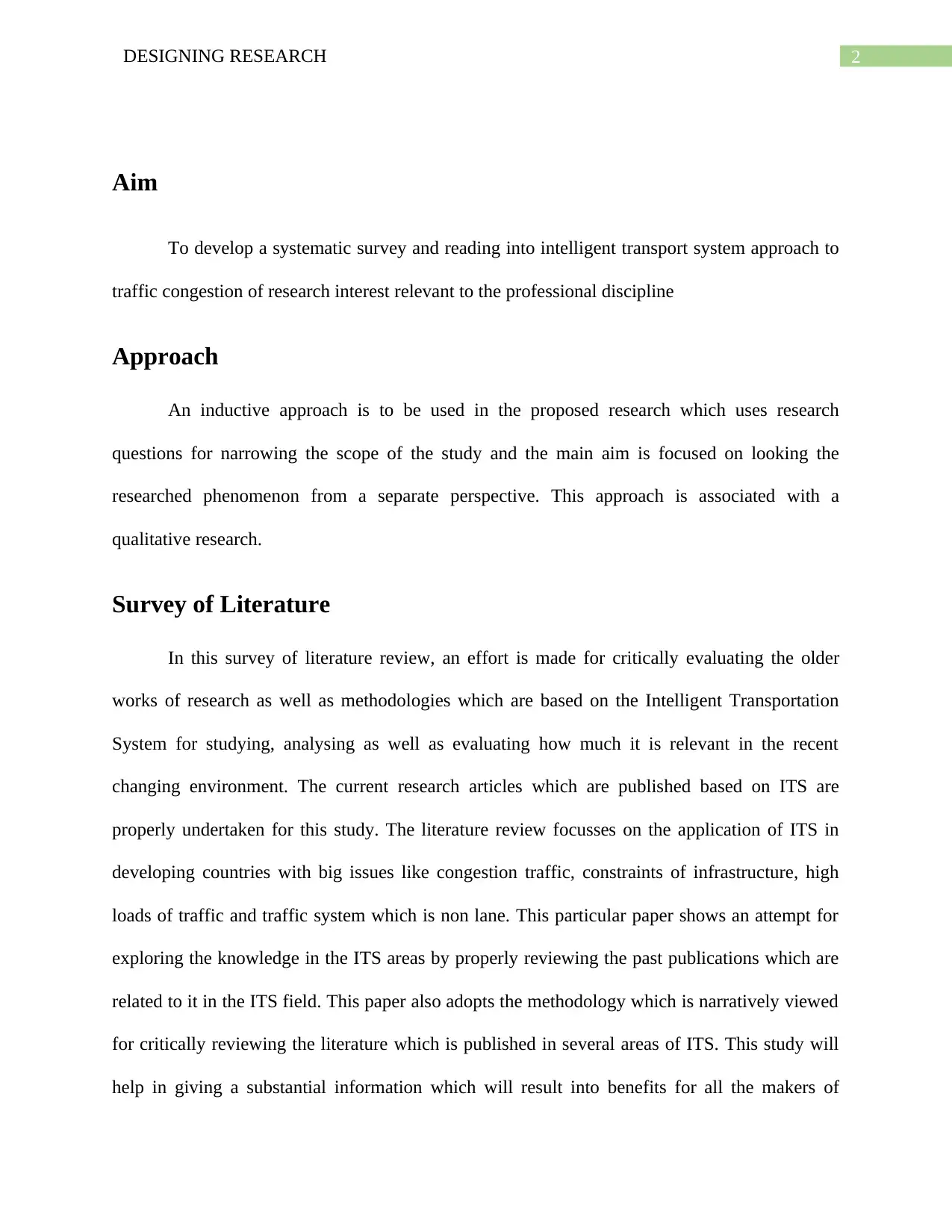
2DESIGNING RESEARCH
Aim
To develop a systematic survey and reading into intelligent transport system approach to
traffic congestion of research interest relevant to the professional discipline
Approach
An inductive approach is to be used in the proposed research which uses research
questions for narrowing the scope of the study and the main aim is focused on looking the
researched phenomenon from a separate perspective. This approach is associated with a
qualitative research.
Survey of Literature
In this survey of literature review, an effort is made for critically evaluating the older
works of research as well as methodologies which are based on the Intelligent Transportation
System for studying, analysing as well as evaluating how much it is relevant in the recent
changing environment. The current research articles which are published based on ITS are
properly undertaken for this study. The literature review focusses on the application of ITS in
developing countries with big issues like congestion traffic, constraints of infrastructure, high
loads of traffic and traffic system which is non lane. This particular paper shows an attempt for
exploring the knowledge in the ITS areas by properly reviewing the past publications which are
related to it in the ITS field. This paper also adopts the methodology which is narratively viewed
for critically reviewing the literature which is published in several areas of ITS. This study will
help in giving a substantial information which will result into benefits for all the makers of
Aim
To develop a systematic survey and reading into intelligent transport system approach to
traffic congestion of research interest relevant to the professional discipline
Approach
An inductive approach is to be used in the proposed research which uses research
questions for narrowing the scope of the study and the main aim is focused on looking the
researched phenomenon from a separate perspective. This approach is associated with a
qualitative research.
Survey of Literature
In this survey of literature review, an effort is made for critically evaluating the older
works of research as well as methodologies which are based on the Intelligent Transportation
System for studying, analysing as well as evaluating how much it is relevant in the recent
changing environment. The current research articles which are published based on ITS are
properly undertaken for this study. The literature review focusses on the application of ITS in
developing countries with big issues like congestion traffic, constraints of infrastructure, high
loads of traffic and traffic system which is non lane. This particular paper shows an attempt for
exploring the knowledge in the ITS areas by properly reviewing the past publications which are
related to it in the ITS field. This paper also adopts the methodology which is narratively viewed
for critically reviewing the literature which is published in several areas of ITS. This study will
help in giving a substantial information which will result into benefits for all the makers of
⊘ This is a preview!⊘
Do you want full access?
Subscribe today to unlock all pages.

Trusted by 1+ million students worldwide
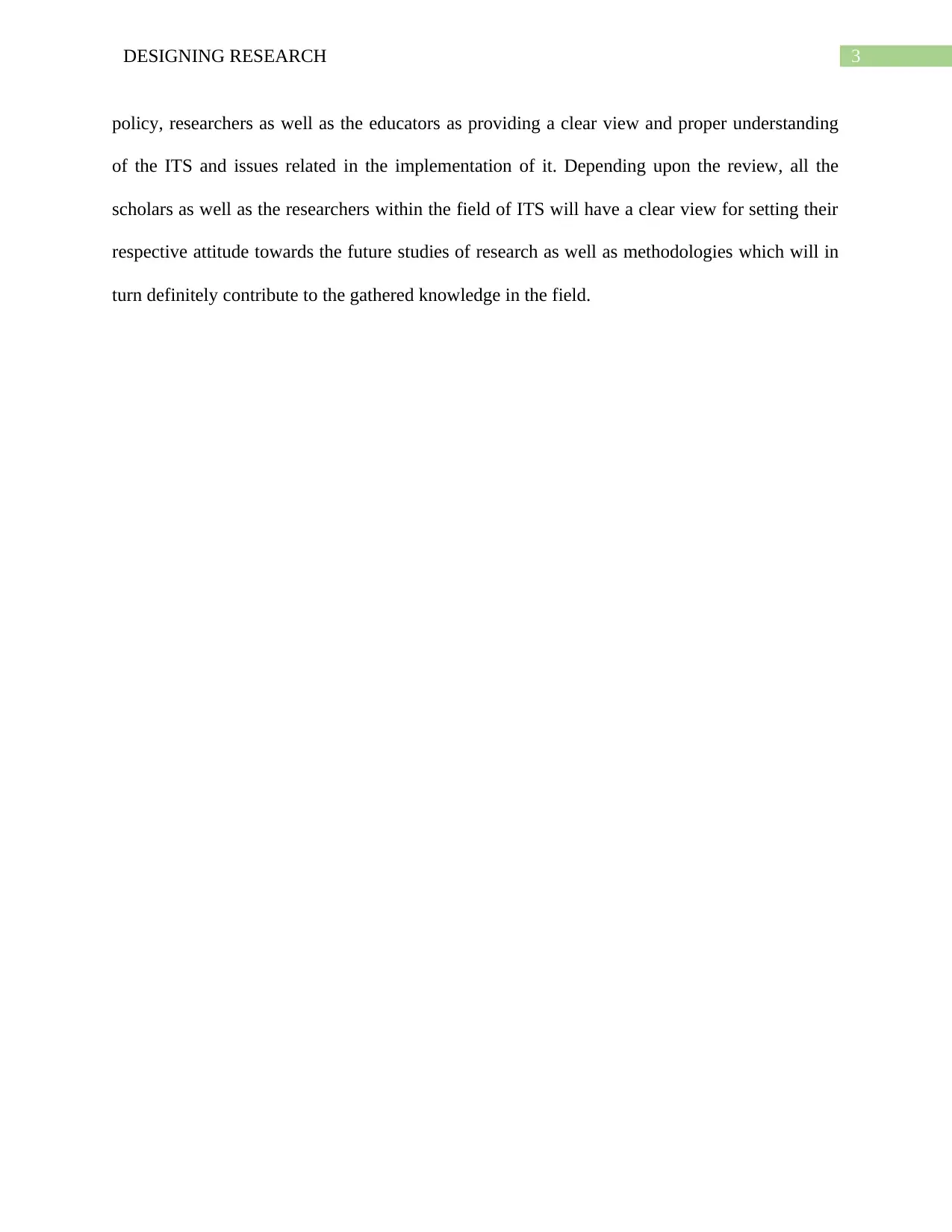
3DESIGNING RESEARCH
policy, researchers as well as the educators as providing a clear view and proper understanding
of the ITS and issues related in the implementation of it. Depending upon the review, all the
scholars as well as the researchers within the field of ITS will have a clear view for setting their
respective attitude towards the future studies of research as well as methodologies which will in
turn definitely contribute to the gathered knowledge in the field.
policy, researchers as well as the educators as providing a clear view and proper understanding
of the ITS and issues related in the implementation of it. Depending upon the review, all the
scholars as well as the researchers within the field of ITS will have a clear view for setting their
respective attitude towards the future studies of research as well as methodologies which will in
turn definitely contribute to the gathered knowledge in the field.
Paraphrase This Document
Need a fresh take? Get an instant paraphrase of this document with our AI Paraphraser
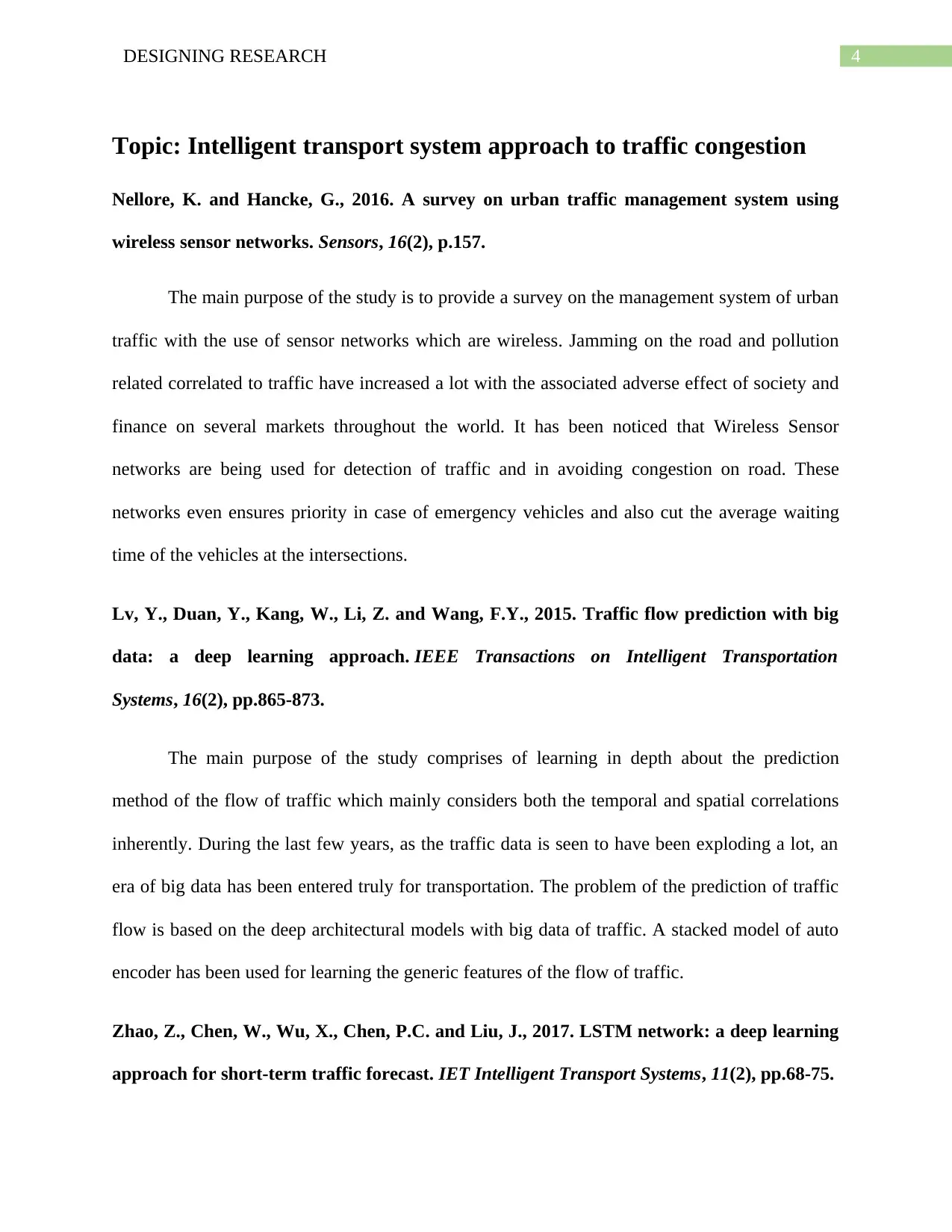
4DESIGNING RESEARCH
Topic: Intelligent transport system approach to traffic congestion
Nellore, K. and Hancke, G., 2016. A survey on urban traffic management system using
wireless sensor networks. Sensors, 16(2), p.157.
The main purpose of the study is to provide a survey on the management system of urban
traffic with the use of sensor networks which are wireless. Jamming on the road and pollution
related correlated to traffic have increased a lot with the associated adverse effect of society and
finance on several markets throughout the world. It has been noticed that Wireless Sensor
networks are being used for detection of traffic and in avoiding congestion on road. These
networks even ensures priority in case of emergency vehicles and also cut the average waiting
time of the vehicles at the intersections.
Lv, Y., Duan, Y., Kang, W., Li, Z. and Wang, F.Y., 2015. Traffic flow prediction with big
data: a deep learning approach. IEEE Transactions on Intelligent Transportation
Systems, 16(2), pp.865-873.
The main purpose of the study comprises of learning in depth about the prediction
method of the flow of traffic which mainly considers both the temporal and spatial correlations
inherently. During the last few years, as the traffic data is seen to have been exploding a lot, an
era of big data has been entered truly for transportation. The problem of the prediction of traffic
flow is based on the deep architectural models with big data of traffic. A stacked model of auto
encoder has been used for learning the generic features of the flow of traffic.
Zhao, Z., Chen, W., Wu, X., Chen, P.C. and Liu, J., 2017. LSTM network: a deep learning
approach for short-term traffic forecast. IET Intelligent Transport Systems, 11(2), pp.68-75.
Topic: Intelligent transport system approach to traffic congestion
Nellore, K. and Hancke, G., 2016. A survey on urban traffic management system using
wireless sensor networks. Sensors, 16(2), p.157.
The main purpose of the study is to provide a survey on the management system of urban
traffic with the use of sensor networks which are wireless. Jamming on the road and pollution
related correlated to traffic have increased a lot with the associated adverse effect of society and
finance on several markets throughout the world. It has been noticed that Wireless Sensor
networks are being used for detection of traffic and in avoiding congestion on road. These
networks even ensures priority in case of emergency vehicles and also cut the average waiting
time of the vehicles at the intersections.
Lv, Y., Duan, Y., Kang, W., Li, Z. and Wang, F.Y., 2015. Traffic flow prediction with big
data: a deep learning approach. IEEE Transactions on Intelligent Transportation
Systems, 16(2), pp.865-873.
The main purpose of the study comprises of learning in depth about the prediction
method of the flow of traffic which mainly considers both the temporal and spatial correlations
inherently. During the last few years, as the traffic data is seen to have been exploding a lot, an
era of big data has been entered truly for transportation. The problem of the prediction of traffic
flow is based on the deep architectural models with big data of traffic. A stacked model of auto
encoder has been used for learning the generic features of the flow of traffic.
Zhao, Z., Chen, W., Wu, X., Chen, P.C. and Liu, J., 2017. LSTM network: a deep learning
approach for short-term traffic forecast. IET Intelligent Transport Systems, 11(2), pp.68-75.

5DESIGNING RESEARCH
The main purpose of the study is to explain short-term forecast of traffic. It is considered
be as an essential issue in intelligent system of transportation. Appropriate forecast allows the
commuters in making proper modes of travel, routes of travel as well as the time of departure
which is very much meaningful in managing traffic. Availability of abundant data of traffic
motives in improving the accuracy of the traffic forecast which is short termed via learning
approaches which are deep. A novel forecast model of traffic which is based on long short
termed memory network is properly proposed. The LSTM network which is proposed mainly
considers the correlation which is temporal spatial in the system of traffic via a network which is
two dimensional composed of a number of memory units.
Hoogendoorn, R., van Arerm, B. and Hoogendoom, S., 2014. Automated driving, traffic
flow efficiency, and human factors: Literature review. Transportation Research
Record, 2422(1), pp.113-120.
The main purpose of the study is to describe how automation is assumed as an impact on
the efficiency of traffic flow which is very much beneficial. This paper basically reviews the
influence of automation on the efficiency of traffic flow and road user’s behaviour and also
formulates a structure of theory. It also identifies the research needs in future. In conclusion it
can be said that automation has an influence on the flow of traffic efficiency and also on the road
user’s behaviour. This research however has some shortcomings and in this part the directions
are mainly formulated for scientific research in future on automation related to the efficiency of
traffic flow and behaviour of human.
The main purpose of the study is to explain short-term forecast of traffic. It is considered
be as an essential issue in intelligent system of transportation. Appropriate forecast allows the
commuters in making proper modes of travel, routes of travel as well as the time of departure
which is very much meaningful in managing traffic. Availability of abundant data of traffic
motives in improving the accuracy of the traffic forecast which is short termed via learning
approaches which are deep. A novel forecast model of traffic which is based on long short
termed memory network is properly proposed. The LSTM network which is proposed mainly
considers the correlation which is temporal spatial in the system of traffic via a network which is
two dimensional composed of a number of memory units.
Hoogendoorn, R., van Arerm, B. and Hoogendoom, S., 2014. Automated driving, traffic
flow efficiency, and human factors: Literature review. Transportation Research
Record, 2422(1), pp.113-120.
The main purpose of the study is to describe how automation is assumed as an impact on
the efficiency of traffic flow which is very much beneficial. This paper basically reviews the
influence of automation on the efficiency of traffic flow and road user’s behaviour and also
formulates a structure of theory. It also identifies the research needs in future. In conclusion it
can be said that automation has an influence on the flow of traffic efficiency and also on the road
user’s behaviour. This research however has some shortcomings and in this part the directions
are mainly formulated for scientific research in future on automation related to the efficiency of
traffic flow and behaviour of human.
⊘ This is a preview!⊘
Do you want full access?
Subscribe today to unlock all pages.

Trusted by 1+ million students worldwide
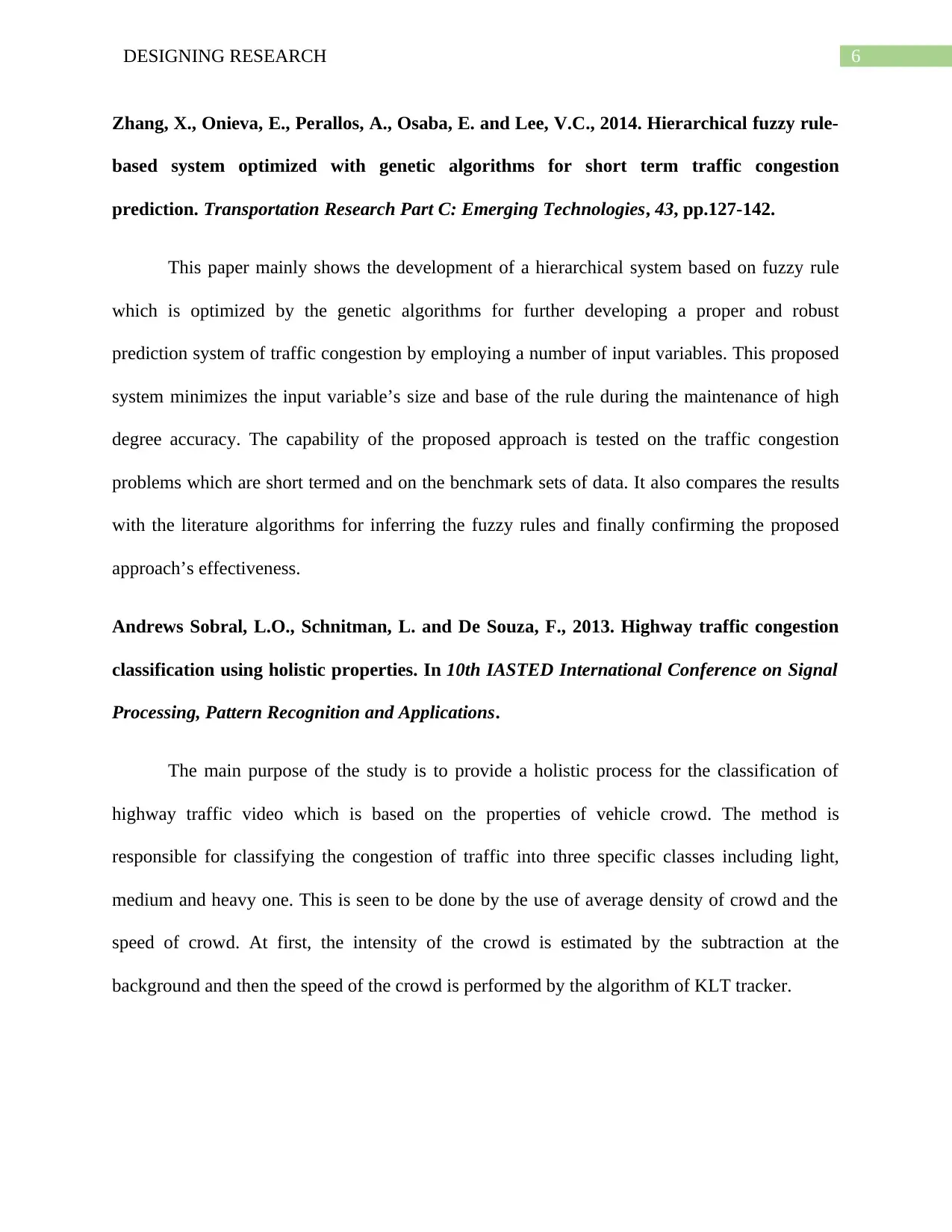
6DESIGNING RESEARCH
Zhang, X., Onieva, E., Perallos, A., Osaba, E. and Lee, V.C., 2014. Hierarchical fuzzy rule-
based system optimized with genetic algorithms for short term traffic congestion
prediction. Transportation Research Part C: Emerging Technologies, 43, pp.127-142.
This paper mainly shows the development of a hierarchical system based on fuzzy rule
which is optimized by the genetic algorithms for further developing a proper and robust
prediction system of traffic congestion by employing a number of input variables. This proposed
system minimizes the input variable’s size and base of the rule during the maintenance of high
degree accuracy. The capability of the proposed approach is tested on the traffic congestion
problems which are short termed and on the benchmark sets of data. It also compares the results
with the literature algorithms for inferring the fuzzy rules and finally confirming the proposed
approach’s effectiveness.
Andrews Sobral, L.O., Schnitman, L. and De Souza, F., 2013. Highway traffic congestion
classification using holistic properties. In 10th IASTED International Conference on Signal
Processing, Pattern Recognition and Applications.
The main purpose of the study is to provide a holistic process for the classification of
highway traffic video which is based on the properties of vehicle crowd. The method is
responsible for classifying the congestion of traffic into three specific classes including light,
medium and heavy one. This is seen to be done by the use of average density of crowd and the
speed of crowd. At first, the intensity of the crowd is estimated by the subtraction at the
background and then the speed of the crowd is performed by the algorithm of KLT tracker.
Zhang, X., Onieva, E., Perallos, A., Osaba, E. and Lee, V.C., 2014. Hierarchical fuzzy rule-
based system optimized with genetic algorithms for short term traffic congestion
prediction. Transportation Research Part C: Emerging Technologies, 43, pp.127-142.
This paper mainly shows the development of a hierarchical system based on fuzzy rule
which is optimized by the genetic algorithms for further developing a proper and robust
prediction system of traffic congestion by employing a number of input variables. This proposed
system minimizes the input variable’s size and base of the rule during the maintenance of high
degree accuracy. The capability of the proposed approach is tested on the traffic congestion
problems which are short termed and on the benchmark sets of data. It also compares the results
with the literature algorithms for inferring the fuzzy rules and finally confirming the proposed
approach’s effectiveness.
Andrews Sobral, L.O., Schnitman, L. and De Souza, F., 2013. Highway traffic congestion
classification using holistic properties. In 10th IASTED International Conference on Signal
Processing, Pattern Recognition and Applications.
The main purpose of the study is to provide a holistic process for the classification of
highway traffic video which is based on the properties of vehicle crowd. The method is
responsible for classifying the congestion of traffic into three specific classes including light,
medium and heavy one. This is seen to be done by the use of average density of crowd and the
speed of crowd. At first, the intensity of the crowd is estimated by the subtraction at the
background and then the speed of the crowd is performed by the algorithm of KLT tracker.
Paraphrase This Document
Need a fresh take? Get an instant paraphrase of this document with our AI Paraphraser
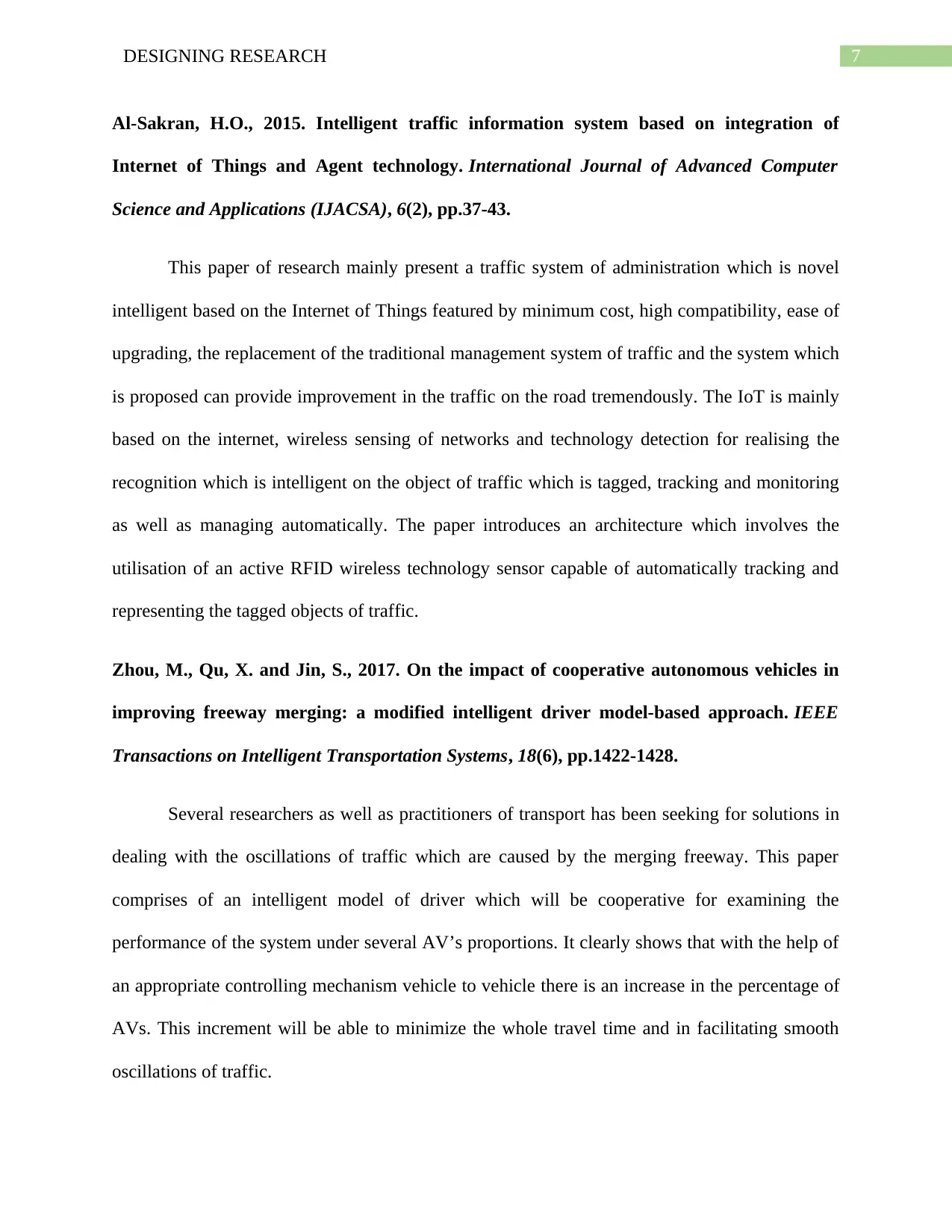
7DESIGNING RESEARCH
Al-Sakran, H.O., 2015. Intelligent traffic information system based on integration of
Internet of Things and Agent technology. International Journal of Advanced Computer
Science and Applications (IJACSA), 6(2), pp.37-43.
This paper of research mainly present a traffic system of administration which is novel
intelligent based on the Internet of Things featured by minimum cost, high compatibility, ease of
upgrading, the replacement of the traditional management system of traffic and the system which
is proposed can provide improvement in the traffic on the road tremendously. The IoT is mainly
based on the internet, wireless sensing of networks and technology detection for realising the
recognition which is intelligent on the object of traffic which is tagged, tracking and monitoring
as well as managing automatically. The paper introduces an architecture which involves the
utilisation of an active RFID wireless technology sensor capable of automatically tracking and
representing the tagged objects of traffic.
Zhou, M., Qu, X. and Jin, S., 2017. On the impact of cooperative autonomous vehicles in
improving freeway merging: a modified intelligent driver model-based approach. IEEE
Transactions on Intelligent Transportation Systems, 18(6), pp.1422-1428.
Several researchers as well as practitioners of transport has been seeking for solutions in
dealing with the oscillations of traffic which are caused by the merging freeway. This paper
comprises of an intelligent model of driver which will be cooperative for examining the
performance of the system under several AV’s proportions. It clearly shows that with the help of
an appropriate controlling mechanism vehicle to vehicle there is an increase in the percentage of
AVs. This increment will be able to minimize the whole travel time and in facilitating smooth
oscillations of traffic.
Al-Sakran, H.O., 2015. Intelligent traffic information system based on integration of
Internet of Things and Agent technology. International Journal of Advanced Computer
Science and Applications (IJACSA), 6(2), pp.37-43.
This paper of research mainly present a traffic system of administration which is novel
intelligent based on the Internet of Things featured by minimum cost, high compatibility, ease of
upgrading, the replacement of the traditional management system of traffic and the system which
is proposed can provide improvement in the traffic on the road tremendously. The IoT is mainly
based on the internet, wireless sensing of networks and technology detection for realising the
recognition which is intelligent on the object of traffic which is tagged, tracking and monitoring
as well as managing automatically. The paper introduces an architecture which involves the
utilisation of an active RFID wireless technology sensor capable of automatically tracking and
representing the tagged objects of traffic.
Zhou, M., Qu, X. and Jin, S., 2017. On the impact of cooperative autonomous vehicles in
improving freeway merging: a modified intelligent driver model-based approach. IEEE
Transactions on Intelligent Transportation Systems, 18(6), pp.1422-1428.
Several researchers as well as practitioners of transport has been seeking for solutions in
dealing with the oscillations of traffic which are caused by the merging freeway. This paper
comprises of an intelligent model of driver which will be cooperative for examining the
performance of the system under several AV’s proportions. It clearly shows that with the help of
an appropriate controlling mechanism vehicle to vehicle there is an increase in the percentage of
AVs. This increment will be able to minimize the whole travel time and in facilitating smooth
oscillations of traffic.
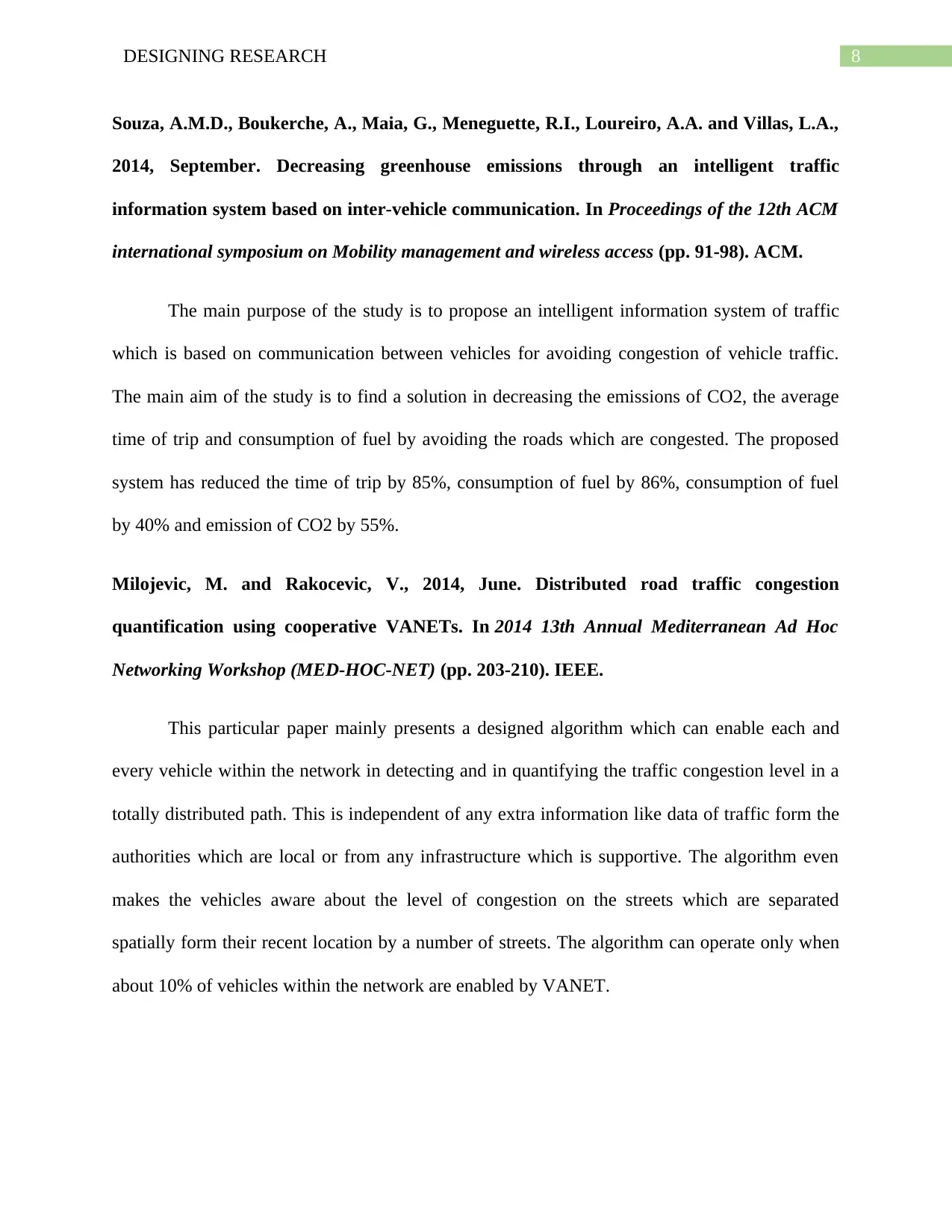
8DESIGNING RESEARCH
Souza, A.M.D., Boukerche, A., Maia, G., Meneguette, R.I., Loureiro, A.A. and Villas, L.A.,
2014, September. Decreasing greenhouse emissions through an intelligent traffic
information system based on inter-vehicle communication. In Proceedings of the 12th ACM
international symposium on Mobility management and wireless access (pp. 91-98). ACM.
The main purpose of the study is to propose an intelligent information system of traffic
which is based on communication between vehicles for avoiding congestion of vehicle traffic.
The main aim of the study is to find a solution in decreasing the emissions of CO2, the average
time of trip and consumption of fuel by avoiding the roads which are congested. The proposed
system has reduced the time of trip by 85%, consumption of fuel by 86%, consumption of fuel
by 40% and emission of CO2 by 55%.
Milojevic, M. and Rakocevic, V., 2014, June. Distributed road traffic congestion
quantification using cooperative VANETs. In 2014 13th Annual Mediterranean Ad Hoc
Networking Workshop (MED-HOC-NET) (pp. 203-210). IEEE.
This particular paper mainly presents a designed algorithm which can enable each and
every vehicle within the network in detecting and in quantifying the traffic congestion level in a
totally distributed path. This is independent of any extra information like data of traffic form the
authorities which are local or from any infrastructure which is supportive. The algorithm even
makes the vehicles aware about the level of congestion on the streets which are separated
spatially form their recent location by a number of streets. The algorithm can operate only when
about 10% of vehicles within the network are enabled by VANET.
Souza, A.M.D., Boukerche, A., Maia, G., Meneguette, R.I., Loureiro, A.A. and Villas, L.A.,
2014, September. Decreasing greenhouse emissions through an intelligent traffic
information system based on inter-vehicle communication. In Proceedings of the 12th ACM
international symposium on Mobility management and wireless access (pp. 91-98). ACM.
The main purpose of the study is to propose an intelligent information system of traffic
which is based on communication between vehicles for avoiding congestion of vehicle traffic.
The main aim of the study is to find a solution in decreasing the emissions of CO2, the average
time of trip and consumption of fuel by avoiding the roads which are congested. The proposed
system has reduced the time of trip by 85%, consumption of fuel by 86%, consumption of fuel
by 40% and emission of CO2 by 55%.
Milojevic, M. and Rakocevic, V., 2014, June. Distributed road traffic congestion
quantification using cooperative VANETs. In 2014 13th Annual Mediterranean Ad Hoc
Networking Workshop (MED-HOC-NET) (pp. 203-210). IEEE.
This particular paper mainly presents a designed algorithm which can enable each and
every vehicle within the network in detecting and in quantifying the traffic congestion level in a
totally distributed path. This is independent of any extra information like data of traffic form the
authorities which are local or from any infrastructure which is supportive. The algorithm even
makes the vehicles aware about the level of congestion on the streets which are separated
spatially form their recent location by a number of streets. The algorithm can operate only when
about 10% of vehicles within the network are enabled by VANET.
⊘ This is a preview!⊘
Do you want full access?
Subscribe today to unlock all pages.

Trusted by 1+ million students worldwide
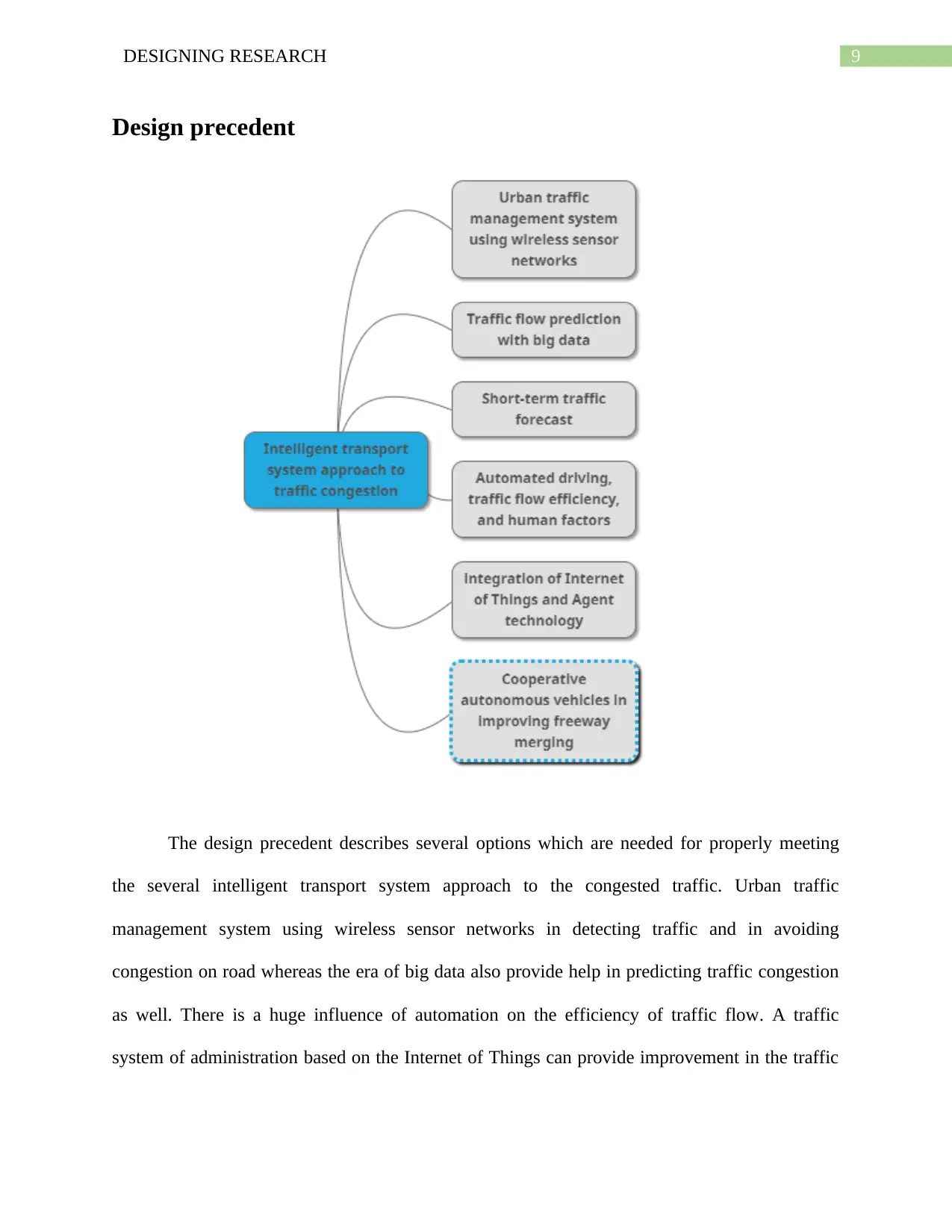
9DESIGNING RESEARCH
Design precedent
The design precedent describes several options which are needed for properly meeting
the several intelligent transport system approach to the congested traffic. Urban traffic
management system using wireless sensor networks in detecting traffic and in avoiding
congestion on road whereas the era of big data also provide help in predicting traffic congestion
as well. There is a huge influence of automation on the efficiency of traffic flow. A traffic
system of administration based on the Internet of Things can provide improvement in the traffic
Design precedent
The design precedent describes several options which are needed for properly meeting
the several intelligent transport system approach to the congested traffic. Urban traffic
management system using wireless sensor networks in detecting traffic and in avoiding
congestion on road whereas the era of big data also provide help in predicting traffic congestion
as well. There is a huge influence of automation on the efficiency of traffic flow. A traffic
system of administration based on the Internet of Things can provide improvement in the traffic
Paraphrase This Document
Need a fresh take? Get an instant paraphrase of this document with our AI Paraphraser
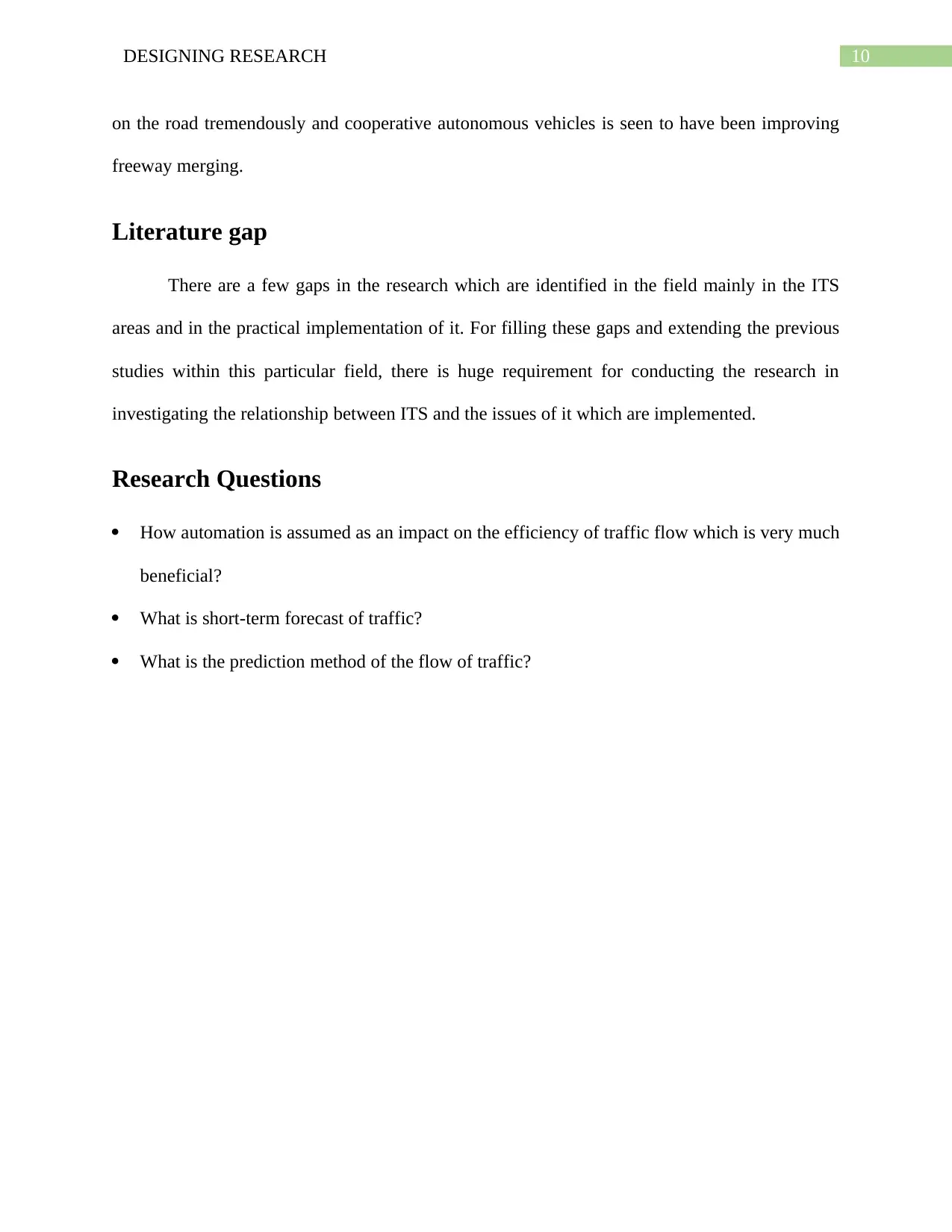
10DESIGNING RESEARCH
on the road tremendously and cooperative autonomous vehicles is seen to have been improving
freeway merging.
Literature gap
There are a few gaps in the research which are identified in the field mainly in the ITS
areas and in the practical implementation of it. For filling these gaps and extending the previous
studies within this particular field, there is huge requirement for conducting the research in
investigating the relationship between ITS and the issues of it which are implemented.
Research Questions
How automation is assumed as an impact on the efficiency of traffic flow which is very much
beneficial?
What is short-term forecast of traffic?
What is the prediction method of the flow of traffic?
on the road tremendously and cooperative autonomous vehicles is seen to have been improving
freeway merging.
Literature gap
There are a few gaps in the research which are identified in the field mainly in the ITS
areas and in the practical implementation of it. For filling these gaps and extending the previous
studies within this particular field, there is huge requirement for conducting the research in
investigating the relationship between ITS and the issues of it which are implemented.
Research Questions
How automation is assumed as an impact on the efficiency of traffic flow which is very much
beneficial?
What is short-term forecast of traffic?
What is the prediction method of the flow of traffic?
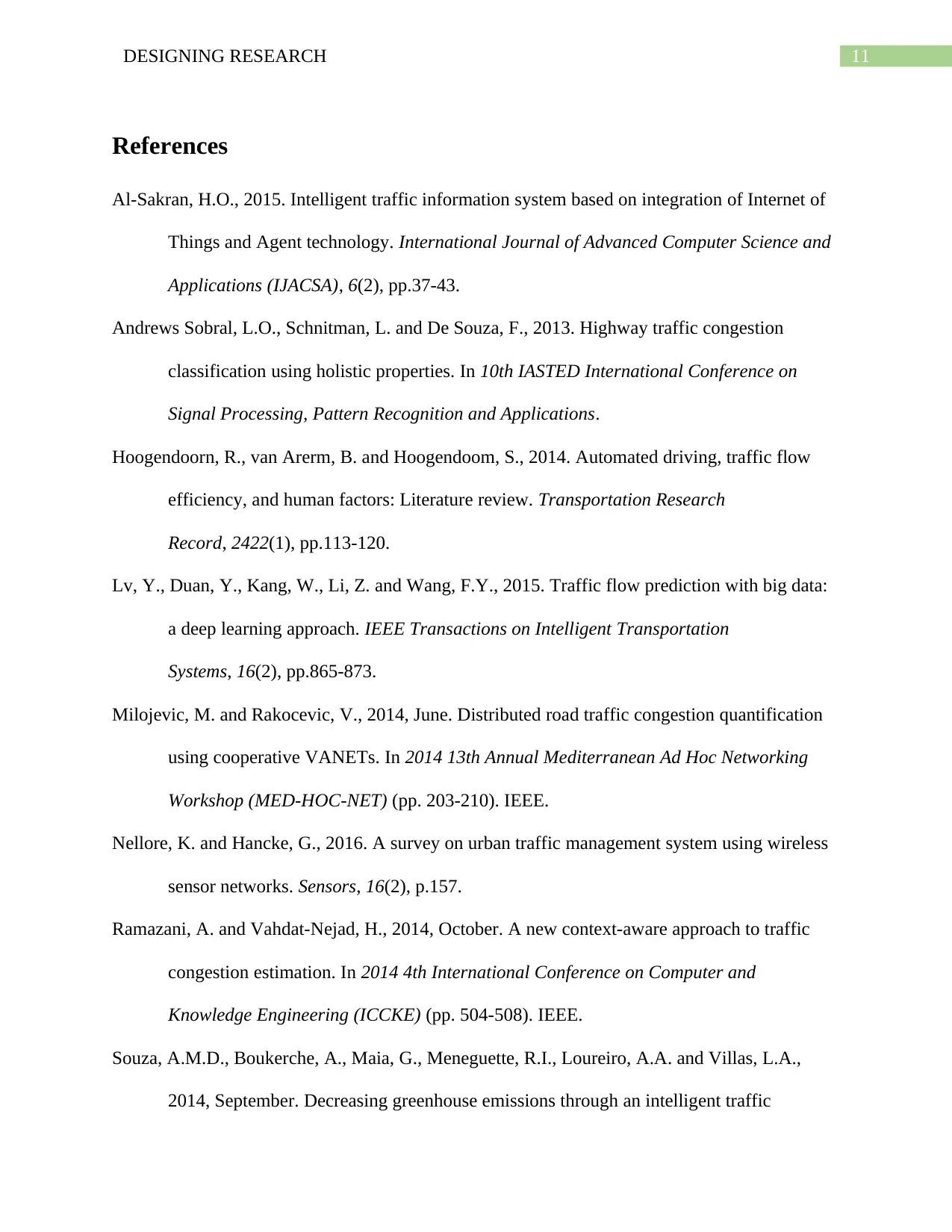
11DESIGNING RESEARCH
References
Al-Sakran, H.O., 2015. Intelligent traffic information system based on integration of Internet of
Things and Agent technology. International Journal of Advanced Computer Science and
Applications (IJACSA), 6(2), pp.37-43.
Andrews Sobral, L.O., Schnitman, L. and De Souza, F., 2013. Highway traffic congestion
classification using holistic properties. In 10th IASTED International Conference on
Signal Processing, Pattern Recognition and Applications.
Hoogendoorn, R., van Arerm, B. and Hoogendoom, S., 2014. Automated driving, traffic flow
efficiency, and human factors: Literature review. Transportation Research
Record, 2422(1), pp.113-120.
Lv, Y., Duan, Y., Kang, W., Li, Z. and Wang, F.Y., 2015. Traffic flow prediction with big data:
a deep learning approach. IEEE Transactions on Intelligent Transportation
Systems, 16(2), pp.865-873.
Milojevic, M. and Rakocevic, V., 2014, June. Distributed road traffic congestion quantification
using cooperative VANETs. In 2014 13th Annual Mediterranean Ad Hoc Networking
Workshop (MED-HOC-NET) (pp. 203-210). IEEE.
Nellore, K. and Hancke, G., 2016. A survey on urban traffic management system using wireless
sensor networks. Sensors, 16(2), p.157.
Ramazani, A. and Vahdat-Nejad, H., 2014, October. A new context-aware approach to traffic
congestion estimation. In 2014 4th International Conference on Computer and
Knowledge Engineering (ICCKE) (pp. 504-508). IEEE.
Souza, A.M.D., Boukerche, A., Maia, G., Meneguette, R.I., Loureiro, A.A. and Villas, L.A.,
2014, September. Decreasing greenhouse emissions through an intelligent traffic
References
Al-Sakran, H.O., 2015. Intelligent traffic information system based on integration of Internet of
Things and Agent technology. International Journal of Advanced Computer Science and
Applications (IJACSA), 6(2), pp.37-43.
Andrews Sobral, L.O., Schnitman, L. and De Souza, F., 2013. Highway traffic congestion
classification using holistic properties. In 10th IASTED International Conference on
Signal Processing, Pattern Recognition and Applications.
Hoogendoorn, R., van Arerm, B. and Hoogendoom, S., 2014. Automated driving, traffic flow
efficiency, and human factors: Literature review. Transportation Research
Record, 2422(1), pp.113-120.
Lv, Y., Duan, Y., Kang, W., Li, Z. and Wang, F.Y., 2015. Traffic flow prediction with big data:
a deep learning approach. IEEE Transactions on Intelligent Transportation
Systems, 16(2), pp.865-873.
Milojevic, M. and Rakocevic, V., 2014, June. Distributed road traffic congestion quantification
using cooperative VANETs. In 2014 13th Annual Mediterranean Ad Hoc Networking
Workshop (MED-HOC-NET) (pp. 203-210). IEEE.
Nellore, K. and Hancke, G., 2016. A survey on urban traffic management system using wireless
sensor networks. Sensors, 16(2), p.157.
Ramazani, A. and Vahdat-Nejad, H., 2014, October. A new context-aware approach to traffic
congestion estimation. In 2014 4th International Conference on Computer and
Knowledge Engineering (ICCKE) (pp. 504-508). IEEE.
Souza, A.M.D., Boukerche, A., Maia, G., Meneguette, R.I., Loureiro, A.A. and Villas, L.A.,
2014, September. Decreasing greenhouse emissions through an intelligent traffic
⊘ This is a preview!⊘
Do you want full access?
Subscribe today to unlock all pages.

Trusted by 1+ million students worldwide
1 out of 14
Related Documents
Your All-in-One AI-Powered Toolkit for Academic Success.
+13062052269
info@desklib.com
Available 24*7 on WhatsApp / Email
![[object Object]](/_next/static/media/star-bottom.7253800d.svg)
Unlock your academic potential
Copyright © 2020–2025 A2Z Services. All Rights Reserved. Developed and managed by ZUCOL.





